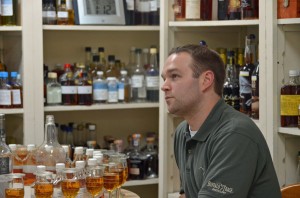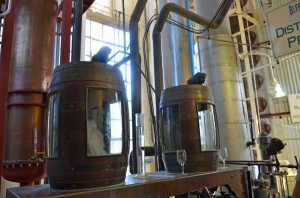Close-Up on Buffalo Trace, Part II
Part 2 of an Interview with Buffalo Trace’s Chris Fletcher, Lead Chemist, and Amy Preske, Public Relations Manager
By Richard Thomas
Jump Back to Part I of this Interview
***

at Buffalo Trace’s tasting round table,
surrounded by experimental batches.
(Credit: Joana Thomas)
RT: Chris, what is your favorite part of being a chemist at Buffalo Trace?
CF: Well, tasting. [Laughter] How could it not be? We have a round table. That gets back to the oldest working thing in the distillery, because I think that table is from the ‘40s or ‘50s. It’s on a Lazy Susan, so it rotates, and that’s how we do our quality control. We bring up the samples and we just line them up, sit down, and taste each one to make sure it fits the flavor profile. Single barrel, Buffalo Trace, Elmer T. Lee, whatever the product would be.
To me, I grew up in the distilling business, and I value both the art and tradition as well as the science. No matter what I do in the lab, the bottom line is still “what does it taste like?” You can’t really develop, I don’t think, an instrument that would replace having a person do that.
RT: What is the hardest part of being a chemist here?
CF: Boy, that’s hard. I’ve never been asked that question before. I guess I’d have to say spitting out when I do tastings [Laughter].
RT: I think a lot of people would sympathize with that.
CF: In all honesty, I think there is a lot of pressure because of our history, and the prestige of a lot of our brands. We win a lot of awards, and that’s one of the things that I’ve really enjoyed since I’ve come over to Buffalo Trace as well. The pride that we take in our products here, and rightfully so. Every distillery does, but I think here we have a little pressure or expectation.
When we’re developing these products, and we’re looking at George T. Stagg for this year…
AP: Right, I mean, it [wins] worldwide whiskey of the year all the time, so there is a lot of pressure on that. [We think] Oh my God, what’s it going to taste like?
CF: We don’t really know until these barrels get so old. I mean, we’re sampling from here and sampling from there. You know, what do we need to do to have the absolute best product we can put in that bottle.
So I’d say the honest answer there is the pressure. But I’d much rather have it that way than working for a place that was putting whatever product out the door.

(Credit: Joana Thomas)
RT: Let’s say one of our readers was in college and thinking about getting into the whiskey biz. What advice would you give him on breaking into the industry in distillation or chemistry?
CF: Well, I think the industry since I’ve been in it, the last 10-plus years, has changed a lot, because there are a lot of smaller distilleries now. When I came in there were just a few big players, and now these smaller distilleries are popping up. So if you wanted to get into fermentation and distillation, the opportunities now are a lot better than it was.
My advice would be focus on biology, yeast metabolism as far as fermentation, studying things like thermodynamics. I think there is also a lot of value on the history and traditions, at least in our part of the industry. I don’t know so much about the small micro-distilleries at this point, but I think someone with a value for the heritage of the bourbon industry, that would go a long way.
My first job in the industry was as a tour guide, so I did that for two summers when I was in college, and it was such a fantastic introduction to the distilling industry, because you got to meet these people, much like yourself, that were interested in the product and how it was made and the history, and kind of had this love for the product inherently that you got to interact with everyday.
So I think anytime you can blend the science with the history, the romanticism of the industry… anytime you can put those two things together, that would be my advice, to do that.
RT: So this would be for both of you. “Sipping whiskey” is a common phrase, conjuring images of sitting out on the porch and unwinding with a finger or two’s worth in the tumbler. What qualities would you personally want in a nice sipping bourbon?
AP: Definitely good nose, and I’m more of a sweet fan, I’m not big on the ryes.

go straight to the still.
(Credit: Joana Thomas)
CF: My answer would be balance. I like to be able to have a little bit of that spice hanging on there, and I like to be able to taste just a bit of the actual spirits in there too, but also the sweet corn flavor. Like what you get in our white dog. Now don’t get me wrong, our white dog isn’t as balanced as what you get after aging in oak, but I do like an equal parts flavor kind of bourbon.
I like personally just the Buffalo Trace. I think here, the eight to ten to twelve years old is where we’re the most balanced. That’s just my flavor profile and what I like. A lot of people like the 15 and 20 year olds, and that’s fantastic.
RT: Do you have any interest in scotch or Irish whiskey? Any favorites? What qualities do you look for there?
CF: I do dabble into a little bit of scotch, from time to time, and that’s about it. My focus is definitely on American whiskey. I’m partial, I’m prejudiced, I really think American whiskeys are made as well as any spirits in the world.
RT: Turning that around, if you were talking to an Irish or Scotch whiskey drinker. What is it about Buffalo Trace’s whiskeys that might appeal to him?
CF: Well, I think the flavors are obviously quite different, just because we’re making our product mostly out of corn, and they’re making mostly out of barley. Why is that? Because corn grows really well here, and historically barley grew really well over there.
But I think what bourbon whiskeys have going for them, getting back to balance, by aging in new oak every time, you get all the sweet caramel and vanilla tones coming from that wood, and less of that smoky peatiness, depending on the scotch you’re drinking.
If I were to recommend something, that would be the Weller 12 Year Old, the wheated bourbon. That softens it up a bit, but I think at 12 years old brings out a nice amount of the smoke and oak along with it. For a scotch drinker, that would be my initial recommendation.
AP: I find a lot of people who come into the gift shop and say “I’ve never had bourbon before,” and they’re a scotch or Irish whiskey drinker, they like the Eagle Rare. That’s usually their favorite.
RT: I live in Portugal, where the only two American whiskeys I can find easily and at reasonable prices are Four Roses and Jack Daniels. Many of our European readers report similar problems. Does Buffalo Trace have any plans to expand its reach in Europe in the near future? Can you help us all out and get us some more quality bourbon and rye?
AP: In England, Buffalo Trace is going like gangbusters. […] Sales in Europe are strong, especially in the UK, but also in other areas of Europe as well. We’re not as strongly distributed over there – yet – as our competitors, but we do have an international sales director who is focused on that. Our first goal is to get better distribution within the United States, which we are doing, and we’ve increased our bourbon production each year in order to be able to better meet the demands. So once we get the U.S. settled, then you’ll see even more of our products in Europe and other overseas markets. It may take us a few more years, since you can’t force Mother Nature in the aging process, but that is our goal!



